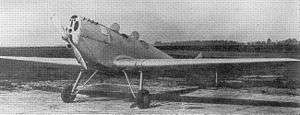Miles Hawk
The Miles M.2 Hawk was a 1930s British two-seat light monoplane designed by Miles Aircraft Limited.
| M.2 Hawk | |
|---|---|
 | |
| Role | Two-seat light monoplane |
| Manufacturer | Miles Aircraft Limited |
| Designer | Frederick George Miles |
| First flight | 29 March 1933 |
| Number built | 47 |
| Unit cost |
395UKP |
| Variants | Miles Hawk Major |
Design and development
The Hawk was designed in 1933 by F.G. Miles. Unusual for the time, the Hawk was a low-wing cantilever monoplane with wings designed to be folded. It had an open cockpit for two in tandem. The prototype powered by a 95 hp ADC Cirrus IIIA engine was built by Philips and Powis Limited (now known as Miles Aircraft) at Woodley Aerodrome and first flew on 29 March 1933.[1] The aircraft sold well for the time, the price of only 395 pounds and the benefits of a monoplane (it did not need to be rigged). A number of one off variants were built, including a cabin monoplane (M.2A), a long-range single-seater (M.2B) and three-seat versions for joy riding (M.2D). In 1934 due to a shortage of Cirrus engines an improved version was introduced, the Miles Hawk Major.
Variants
- M.2
- Production two-seat version with one 95 hp A.D.C. Cirrus IIIA engine.
- M.2A
- Cabin version powered by a de Havilland Gipsy III engine, one built.
- M.2B
- Long-range single-seater powered by an A.D.C Cirrus Hermes IV, one-built.
- M.2C
- Re-engined with one 120 hp de Havilland Gipsy III engine, one built.
- M.2D
- Three-seat version with one 95 hp A.D.C. Cirrus IIIA engine, six built.
Operators
Military operators
- Royal Australian Air Force - Two aircraft
Specifications (M.2)

Data from British Civil Aircraft 1919–1972: Volume III[2]
General characteristics
- Capacity: Two
- Length: 24 ft 0 in (7.32 m)
- Wingspan: 33 ft 0 in (10.06 m)
- Height: 6 ft 8 in (2.03 m)
- Wing area: 169 sq ft (15.7 m2)
- Empty weight: 1,014 lb (460 kg)
- Gross weight: 1,800 lb (816 kg)
- Powerplant: 1 × ADC Cirrus IIIA piston engine , 95 hp (71 kW)
Performance
- Maximum speed: 115 mph (185 km/h, 100 kn)
- Cruise speed: 100 mph (160 km/h, 87 kn)
- Range: 450 mi (720 km, 390 nmi)
- Service ceiling: 16,000 ft (4,900 m)
- Rate of climb: 860 ft/min (4.4 m/s)
See also
Related development
Aircraft of comparable role, configuration and era
References
| Wikimedia Commons has media related to Miles Hawk. |
Notes
- Jackson 1988, p. 43.
- Jackson 1988, p. 467.
Bibliography
- Amos, Peter. and Brown, Don Lambert. Miles Aircraft Since 1925, Volume 1. London: Putnam Aeronautical, 2000. ISBN 0-85177-787-2.
- Brown, Don Lambert. Miles Aircraft Since 1925. London: Putnam & Company Ltd., 1970. ISBN 0-370-00127-3.
- The Illustrated Encyclopedia of Aircraft (Part Work 1982-1985). Orbis Publishing.
- Jackson, A.J. British Civil Aircraft since 1919. London: Putnam, 1974. ISBN 0-370-10014-X.
- Jackson, A.J. British Civil Aircraft 1192–1972 Volume 3. London: Putnam, 1988. ISBN 0-85177-818-6.